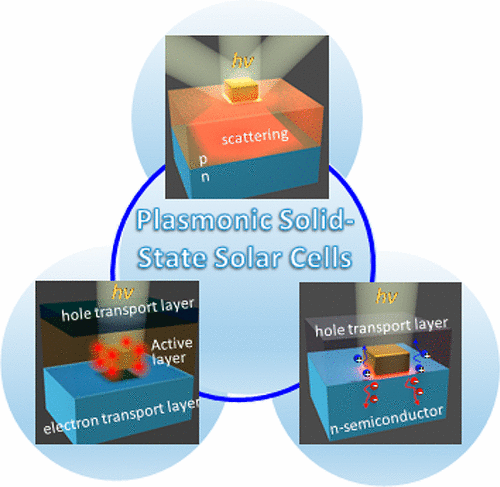当前位置:
X-MOL 学术
›
Chem. Rev.
›
论文详情
Our official English website, www.x-mol.net, welcomes your feedback! (Note: you will need to create a separate account there.)
Solid-State Plasmonic Solar Cells
Chemical Reviews ( IF 62.1 ) Pub Date : 2017-07-24 00:00:00 , DOI: 10.1021/acs.chemrev.7b00235 Kosei Ueno,Tomoya Oshikiri,Quan Sun,Xu Shi,Hiroaki Misawa
Chemical Reviews ( IF 62.1 ) Pub Date : 2017-07-24 00:00:00 , DOI: 10.1021/acs.chemrev.7b00235 Kosei Ueno,Tomoya Oshikiri,Quan Sun,Xu Shi,Hiroaki Misawa

|
Metallic nanoparticles such as silver and gold show localized surface plasmon resonances (LSPRs), which are associated with near-field enhancement effects in the vicinity of nanoparticles. Therefore, strong light–matter interaction is induced by the near-field enhancement effects of LSPRs. Because the resonant wavelength of LSPRs can be easily controlled by the size and shape of the metallic nanoparticles in the visible and near-infrared wavelength range, LSPRs have received considerable attention as optical antennae for light energy conversion systems such as solar cells. LSPRs decay very quickly as a result of light scattering and excitation of electron–hole pairs in the metal itself. However, in addition to the near-field enhancement effect, this light scattering and electron–hole pair excitation, which are known to cause loss of LSPRs, can be utilized as a solar cell enhancement mechanism. Here, we focus on plasmonic solid-state solar cells. The mechanisms of the light scattering by LSPRs, near-field enhancement, and plasmon-induced charge separation based on electron–hole pair excitations can be clarified. We review the related studies from the viewpoint of these mechanisms rather than material science.
中文翻译:

固态等离子太阳能电池
金属纳米粒子(例如银和金)显示出局部表面等离子体共振(LSPR),这与纳米粒子附近的近场增强效应相关。因此,LSPRs的近场增强效应引起强烈的光-物质相互作用。由于LSPR的共振波长可以通过可见和近红外波长范围内的金属纳米粒子的大小和形状轻松控制,因此LSPR作为光能转换系统(例如太阳能电池)的光学天线受到了广泛的关注。由于光散射和金属本身中电子-空穴对的激发,LSPR衰减非常快。但是,除了近场增强效应外,这种光散射和电子-空穴对激发也已知会引起LSPR的损失,可以用作太阳能电池增强机制。在这里,我们关注等离子固态太阳能电池。可以阐明LSPR引起的光散射,近场增强以及基于电子-空穴对激发的等离激元诱导的电荷分离的机制。我们从这些机制而不是材料科学的角度回顾了相关研究。
更新日期:2017-07-24
中文翻译:

固态等离子太阳能电池
金属纳米粒子(例如银和金)显示出局部表面等离子体共振(LSPR),这与纳米粒子附近的近场增强效应相关。因此,LSPRs的近场增强效应引起强烈的光-物质相互作用。由于LSPR的共振波长可以通过可见和近红外波长范围内的金属纳米粒子的大小和形状轻松控制,因此LSPR作为光能转换系统(例如太阳能电池)的光学天线受到了广泛的关注。由于光散射和金属本身中电子-空穴对的激发,LSPR衰减非常快。但是,除了近场增强效应外,这种光散射和电子-空穴对激发也已知会引起LSPR的损失,可以用作太阳能电池增强机制。在这里,我们关注等离子固态太阳能电池。可以阐明LSPR引起的光散射,近场增强以及基于电子-空穴对激发的等离激元诱导的电荷分离的机制。我们从这些机制而不是材料科学的角度回顾了相关研究。


























 京公网安备 11010802027423号
京公网安备 11010802027423号